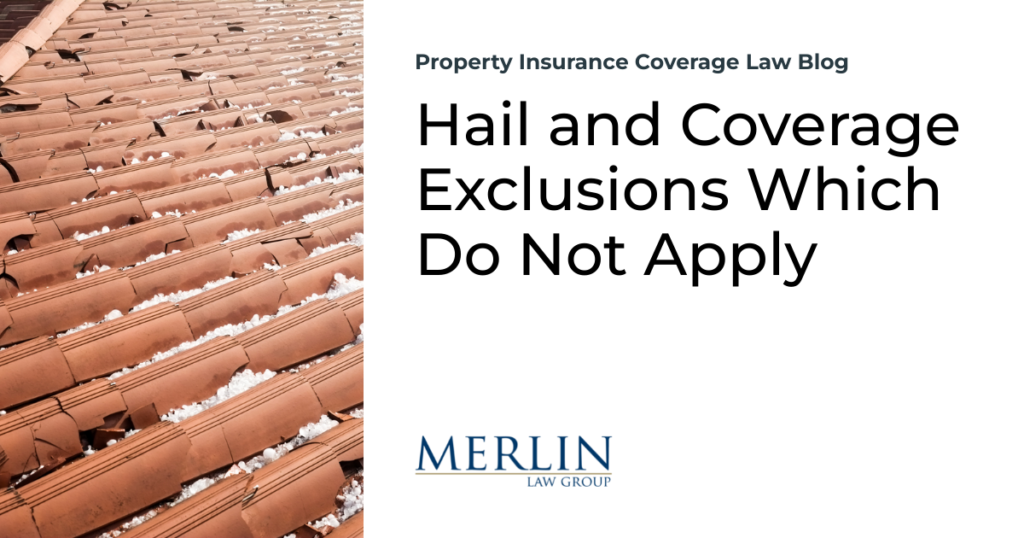Hail and Coverage Exclusions Which Do Not Apply

Hail damage is a topic of discussion at the Rocky Mountain Association of Public Insurance Adjusters (RMAPIA) Fall Seminar. Mike Poli provided a speech, Traps For the Unwary, and highlighted an Arizona insurance decision,1 which has an excellent discussion about how wear and tear, inadequate maintenance, and concurrent cause exclusions operate in the context of a hail loss.
The court stated this about the wear and tear exclusion:
Wear and Tear.
The relevant section of the policy states:
[I.]B. Exclusions
…
2. We will not pay for loss or damage caused by or resulting from any of the following:
…
l. Other Types of Loss (1) Wear and tear;
…
But if an excluded cause of loss that is listed in Paragraphs (1) through (7) above results in a ‘specified cause of loss’ or building glass breakage, we will pay for the loss or damage caused by that ‘specified cause of loss’ or building glass breakage.
The policy clearly and unambiguously excludes coverage where wear and tear is the sole cause of damage. The last sentence quoted above clearly states, however, that the exclusion of coverage in Section I.B.2.1 does not apply— in other words, the policy provides coverage—where an ‘excluded cause of loss’ results in a ‘specified cause of loss.’ The phrase ‘specified cause of loss’ is defined in Section I.H.11 to include ‘hail.’ Therefore, replacing ‘excluded cause of loss’ with ‘wear and tear,’ and ‘specified cause of loss’ with ‘loss from hail,’ the clause reads: ‘if [wear and tear] results in [loss from hail], we will pay for the loss or damage caused by that [hail].’ Thus, when wear and tear contribute to damage by a hailstorm, the policy provides coverage for the hail damage. Further, the policy covers any ensuing damage from the hail, such as water penetrating the roof as a result of the hail.
Regarding the exclusion for inadequate maintenance, the court noted the following:
Inadequate maintenance.
The relevant section of the policy states:
[I.]B. Exceptions …
3. We will not pay for loss or damage caused by or resulting from any of the following Paragraphs a through c. But [i]f an excluded cause of loss that is listed in Paragraphs a through c results in a Covered Cause of Loss, we will pay for the loss or damage caused by that Covered Cause of Loss.
…
c. Negligent Work
Faulty, inadequate or defective … Maintenance;
For purposes of this issue, the ‘excluded cause of loss’ can be stated as ‘inadequate maintenance.’ The ‘Covered Cause of Loss’ can be stated as ‘hail’ or ‘loss from hail’ because hail presents a ‘risk of physical loss’ and is not excluded by the policy. Using these substitutes, the key provision reads: ‘if [inadequate maintenance] results in [loss from hail], we will pay for the loss or damage caused by [the hail].’ This produces the same result as the wear and tear exclusion discussed above. Thus, when inadequate maintenance permits hail damage to occur, the policy provides coverage for the hail damage.
The court then made this very simple conclusion when confronted with hail damage:
The policy provides coverage from damage by hail whether the damage is the sole or partial cause of the loss. The policy does not provide coverage where hail is not responsible for the loss.
Insurance companies and their experts often overuse the wear and tear exclusion as a reason for denial, as noted in Why is the Carrier so Quick to Argue the Wear and Tear Exclusion? I strongly encourage those with questionable denials as a result of wear and tear to read the Insurance Journal article by Bill Wilson, Wear and Tear Exclusions Worn and Torn.
Thought For The Day
Nothing is permanent in this wicked world — not even our troubles.
—Charlie Chaplin
1 Monterra Apts. Ltd. V. Sequoia Ins. Co., No CV11-1236 (D. Ariz. Mar. 12, 2012).







